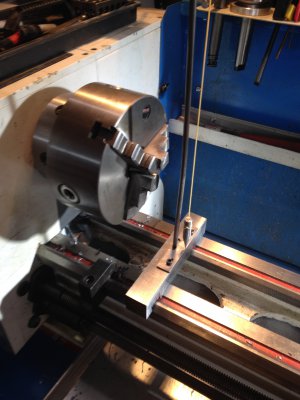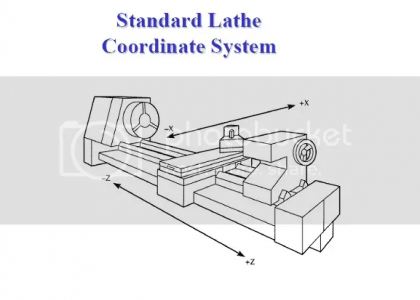I noticed that I have been cutting a lot of tapers lately. I wanted to get the lathe dead on to do a steam engine and taper in the cylinder bore isn't a good idea. The mill has been hit or miss but hasn't bothered what I made. The lathe was leveled originally with a Starrett 98-6 level. I made this plum-bob to tryout. The idea came from Dale @ Build Something Cool. Building it was an adventure. I wanted to get really good tolerances on the mill so the item would sit straight. Come to find out, my vise was crooked and the bed out of tram. And the whole d*** machine was out of level. Got that taken care of. Have .001 over 7" and my Coffee doesn't slide down the bed. 
The plum-bob is worth it. I made a sliding scale with a center line and grooves every .030". 001 out of level is about 1/2 a division. Real easy to adjust vs the level. The lathe is about .002 down in the front but dead level along the X axis and no twist. Cut the taper down to a very little. A few tenths over 3" in the chuck and less than that over 8" center to center. I Use the level for the X axis and the plum-bob for the Y. Works great! You can stop the plum-bob in 1/2 the time it takes for the level to settle. The fun part is watching the plum-bob swing back and forth from the earth rotation. 20" of fishing line is enough to show this. I should have realized this as there is a science museum in Winston Salem with a big plum-bob that swings back and forth across a circle all day.
Three days later I have a level Mill and Lathe and a plum-bob for quick checking that won't break if I drop it. On to making keys for the vise so it can't move again.

The plum-bob is worth it. I made a sliding scale with a center line and grooves every .030". 001 out of level is about 1/2 a division. Real easy to adjust vs the level. The lathe is about .002 down in the front but dead level along the X axis and no twist. Cut the taper down to a very little. A few tenths over 3" in the chuck and less than that over 8" center to center. I Use the level for the X axis and the plum-bob for the Y. Works great! You can stop the plum-bob in 1/2 the time it takes for the level to settle. The fun part is watching the plum-bob swing back and forth from the earth rotation. 20" of fishing line is enough to show this. I should have realized this as there is a science museum in Winston Salem with a big plum-bob that swings back and forth across a circle all day.
Three days later I have a level Mill and Lathe and a plum-bob for quick checking that won't break if I drop it. On to making keys for the vise so it can't move again.



